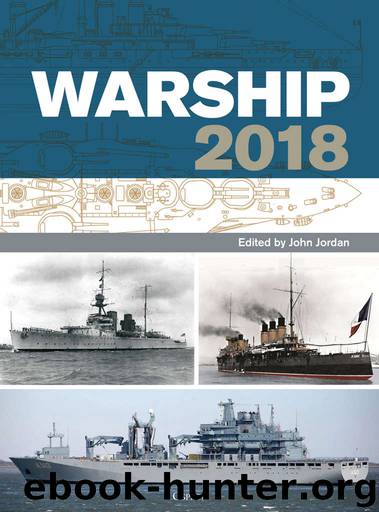Warship 2018 by John Jordan

Author:John Jordan [Jordan, John]
Language: eng
Format: epub
ISBN: 9781472830005
Publisher: Bloomsbury Publishing
Published: 2018-05-30T23:00:00+00:00
Russian 12in Monitor
A very simple design for a monitor with a twin 12in turret, drawn up by the Putilovskii Works circa the spring of 1915. The one questionable feature is the location of the 12in turret, which seems too far forward, and would possibly have caused John Jordan problems 2016 with the trim. (© John Jordan, based on a drawing in RGAVMF f 876, op 173, d 369)
Nothing came of Kononov’s proposal, but soon after the war began the requirement he had foreseen gained a new urgency. In the autumn of 1914, as the Russian Army’s tremendous losses continued to mount, her allies began to worry that Russia might decide to seek a separate peace; as an incentive for staying in the war, on 12 November 1914 Britain agreed to Russian control over Constantinople once victory had been achieved. This was a compelling offer – possession of Constantinople would have fulfilled an ancient Russia goal and provided unhindered access to the Mediterranean. So in February 1915, with the Anglo-French attack on the Dardanelles in prospect, the Emperor ordered that the Black Sea Fleet undertake preparations for an expedition to seize the Bosporus. The prospect of such an operation is presumably what spurred the Russians in the spring of 1915 to ask the British firm of Vickers to run up some sketches of monitors mounting battleship-sized guns.8 It may be that the Russians had heard something about the British Abercrombie class monitors, laid down December 1914. The two monitor designs drawn up by Vickers had the specifications shown in Table 1; the characteristics of the first British big-gun monitor, Abercrombie, are provided for comparison. Design 739 was considerably smaller than the first British big-gun monitors, and it is not clear if the hull was to be provided with bulges akin to those of the British ships, since Vickers was not building any monitors at the time and may not have been aware of them. However, if the Vickers proposals were to be fitted with bulges, it is likely that the speed would have been considerably less than estimated – the British monitors were designed for 10 knots, but in fact managed only 6.5–7.6 knots due to their unusual hull form.
At about the same time as the Vickers designs were delivered, several monitor designs were prepared in Russia. Much uncertainty attaches to these designs, which were prepared by the Putilovskii Works in Petrograd (formerly Saint Petersburg); not even their date is known. It seems likely that they also date from the spring of 1915, before full details of the British monitors were known to the Russians, since they lack anti-torpedo bulges. Although a series of designs was evidently prepared, only a single sketch, with the accompanying characteristics, survives; nor are there any papers to explain the rationale behind them. It seems most likely that these sketches were inspired by the Vickers drawings and were designed to approximately the same requirements. The characteristics of the surviving variant are outlined in Table 2.
The design
Download
This site does not store any files on its server. We only index and link to content provided by other sites. Please contact the content providers to delete copyright contents if any and email us, we'll remove relevant links or contents immediately.
| Africa | Americas |
| Arctic & Antarctica | Asia |
| Australia & Oceania | Europe |
| Middle East | Russia |
| United States | World |
| Ancient Civilizations | Military |
| Historical Study & Educational Resources |
The Radium Girls by Kate Moore(11621)
100 Deadly Skills by Clint Emerson(4690)
The Templars by Dan Jones(4557)
Rise and Kill First by Ronen Bergman(4545)
The Doomsday Machine by Daniel Ellsberg(4245)
The Rape of Nanking by Iris Chang(4022)
Killing England by Bill O'Reilly(3897)
Hitler in Los Angeles by Steven J. Ross(3798)
Stalin by Stephen Kotkin(3724)
12 Strong by Doug Stanton(3419)
Hitler's Monsters by Eric Kurlander(3164)
Blood and Sand by Alex Von Tunzelmann(3055)
Darkest Hour by Anthony McCarten(3018)
The Code Book by Simon Singh(2856)
The Art of War Visualized by Jessica Hagy(2839)
Hitler's Flying Saucers: A Guide to German Flying Discs of the Second World War by Stevens Henry(2624)
Babylon's Ark by Lawrence Anthony(2429)
The Second World Wars by Victor Davis Hanson(2421)
Tobruk by Peter Fitzsimons(2374)
